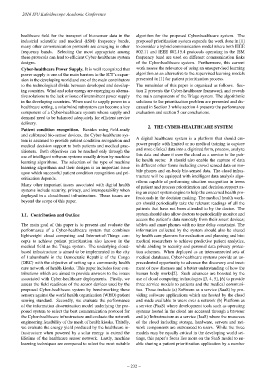Page 250 - ITU Kaleidoscope 2016
P. 250
2016 ITU Kaleidoscope Academic Conference
healthcare field for the transport of bio-sensor data in the algorithm for the proposed Cyber-healthcare system. The
industrial scientific and medical (ISM) frequency bands, proposed prioritization system expands the work done in [1]
many other communication protocols are emerging in other to consider a hybrid communication model where both IEEE
frequency bands. Selecting the most appropriate among 802.11 and IEEE 802.15.4 protocols operating in the ISM
these protocols can lead to efficient Cyber-healthcare system frequency band are used on different communication links
designs. of the Cyber-healthcare system. Furthermore, this current
Cyber-healthcare Power Supply. It is well recognized that work assess the relevance of using an unsupervised learning
power supply is one of the main barriers to the ICT’s expan- algorithm as an alternative to the supervised learning models
sion in the developing world and one of the main contributors presented in [1] for patient prioritization process.
to the technological divide between developed and develop- The remainder of this paper is organized as follows. Sec-
ing countries. Wind and solar energy are emerging as alterna- tion 2 presents the Cyber-healthcare framework and reveals
tive solutions to the lack or issue of intermittent power supply the main components of the Triage system. The algorithmic
in the developing countries. When used to supply power in a solutions to the prioritization problem are presented and dis-
healthcare setting, a solar/wind subsystem can become a key cussed in Section 3 while section 4 presents the performance
component of a Cyber-healthcare system whose supply and evaluation and section 5 our conclusions.
demand need to be balanced adequately for efficient service
delivery.
2. THE CYBER-HEALTHCARE SYSTEM
Patient condition recognition. Besides using field-ready
and calibrated bio-sensor devices, the Cyber-healthcare sys-
A digital healthcare system is a platform that should em-
tem is assumed to provide patient condition recognition and
power people with limited or no medical training to capture
medical decision support to both patients and medical prac-
and store clinical data into a digitized form, process, analyze
titioners. Both objectives can be reached only through the
this data and share it over the cloud as a service to the pub-
use of intelligent software systems usually driven by machine
lic health sector. It should also enable the capture of data
learning algorithms. The selection of the type of machine
in different other forms including crowd sensed data on mo-
learning algorithms and their designs is an important issue
bile phones and on-body bio-sensed data. The cloud infras-
upon which successful patient condition recognition and pri-
tructure will be equipped with intelligent data analysis algo-
oritization depends.
rithms capable of performing situation recognition in terms
Many other important issues associated with digital health
of patient and process prioritization and decision support us-
systems include security, privacy, and interoperability when
ing an expert system engine to help the concerned health pro-
deployed in a cloud-based infrastructure. These issues are
fessionals in the decision making. The medical health work-
beyond the scope of this paper.
ers should periodically take the relevant readings of all the
patients that have not been attended to by the doctor. The
1.1. Contribution and Outline system should also allow doctors to periodically monitor and
access the patient’s data remotely from their smart devices;
The main goal of this paper is to present and evaluate the tablets and smart phones with no time delay constraint. The
performance of a Cyber-healthcare system that combines information collected by the system should also be shared
lightweight cloud computing and Internet-of-Things con- by health care planners for evaluation and planning and bio-
cepts to achieve patient prioritization also known in the medical researchers to achieve predictive patient analytics,
medical field as the Triage system. The underlying cloud- while abiding to security and personal data privacy protec-
based infrastructure is aimed to be implemented in the city tion schemes. When deployed as an interconnected sets of
of Lubambashi in the Democratic Republic of the Congo medical databases, Cyber-healthcare systems provide an un-
(DRC) with the objective of setting up a community health precedented opportunity to advance the discovery and treat-
care network of health kiosks. This paper includes four con- ment of new diseases and a better understanding of how the
tributions which are aimed to provide answers to the issues human body works[2]. Such advances are boosted by the
associated with Cyber-healthcare deployments. Firstly, we use of cloud computing technologies [3, 4, 5], [6] to provide
assess the field readiness of the sensor devices used by the three service models to patients and the medical communi-
proposed Cyber-healthcare system by benchmarking these ties. These include (a) Software as a service (SaaS) by pro-
sensors against the world health organization (WHO) patient viding software applications which are hosted by the cloud
scoring standard. Secondly, we evaluate the performance and made available to users over a network (b) Platform as
of the information dissemination model underlying the pro- a service (PaaS) where development tools such as operating
posed system to select the best communication protocol for systems hosted in the cloud are accessed through a browser
the Cyber-healthcare infrastructure and evaluate the network and (c) Infrastructure as a service (IaaS) where the resources
engineering feasibility of the mesh of health kiosks. Thirdly, of the cloud including storage, hardware, servers and net-
we evaluate the energy yield produced by the healthcare in- work components are outsourced to users. While the three
frastructure when powered by a solar energy to extend the models may be equally critical in the developing world set-
lifetime of the healthcare sensor network. Lastly, machine tings, this paper’s focus lies more on the SaaS model to en-
learning techniques are compared to select the most suitable able sharing a patient prioritization application by a number
– 232 –

